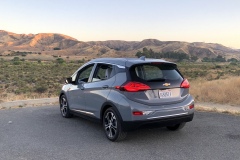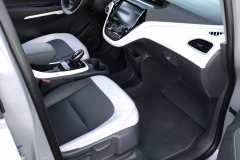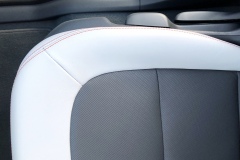Take Three: The Affordable 259-Mile Driving Range Electric
Four years ago Chevrolet introduced the all-electric Bolt with a 238-mile driving range and a starting price of $37,495. Aimed directly at the Tesla Model 3 (and beating it to the market by six months), the Bolt offered a reasonable alternative to the initially much pricier Tesla. Not much changed from 2017-2019 for the Bolt, relegating consumers that needed, or thought they needed, more driving range forced to look elsewhere than their Chevrolet dealer. Then, in the Bolt’s fourth year, a much-needed announcement.

The 2020 Chevrolet Bolt now has a 259-mile driving range. That additional 20 miles may not seem all that significant, but it is. The Bolt, if driven judiciously, has been proven to go more than 300 miles on a charge by owners maximizing the battery through regeneration. Clean Fleet Report was able, at our most efficient driving, get an impressive 2.9 miles/kilowatt-hour (kWh). Anything under 4.0 mi/kWh is considered good.
The Driving Experience: On the Road
Powered by a 150-kW electric motor driving the front wheels, the 200 horsepower and 266 pound-feet of torque zips the Bolt around with great fun. The 6.5-second zero-to-60 time and a 91 mph top speed (please don’t go this fast!) were plenty to move the 3,563-pound small wagon down the road. If driving an electric car is new to you, then the instant torque at any speed will be an eye opener. The torque at highway speeds is not as aggressive as when accelerating from a stop, but it is plenty to pass an 18-wheeler or a Class A motorhome clogging the lane.

What you will notice, well actually not notice, is any noise other than what may come from the tires and a bit of wind. The ride is generally quiet, but with an upright tall wagon exterior design, the 0.32 coefficient of drag (Cd) is not as slick through the wind as competitor EVs, such as the Hyundai Ioniq, Hyundai Kona and Tesla Model 3 that come in between 0.24 and 0.29 Cd.
The batteries, located under the seats, made for a sure-footed driving experience that truly shines in city maneuvers and around tight corners. Considering it comes with all-season, puncture-sealing, 17-inch Michelin Energy Saver tires that are designed for low rolling-resistance and not performance, Chevrolet designed the Bolt with overall good handling. We did notice, when on uneven surfaces or hitting the inevitable road cracks, dips and potholes, the Bolt could have a rough and jarring ride. The electric power steering was not too light, and body roll, even when pushed above recommended corner speed limits, was predictable and minor. Highway 65+ mph cruising was solid and confident.
There is a choice of driving modes that affects the regenerative braking, which determines how much electricity is returned to the battery. Selecting the Drive mode, the brake pedal is used as normal for slowing and stopping. Using the Low mode, you can control braking with the accelerator pedal and your fingertips to maximize the battery charge. Found on the left side behind the steering wheel is a paddle that, when blipped once, twice and even a third time, progressively increases the regenerative braking. The cool factor is once you get the hang of it the Bolt can be driven without using the brake pedal, including coming to a complete stop. This technique, called “one pedal driving,†lends itself to getting the most electricity from regenerative braking as fingertips are far more sensitive than a foot tromping on the brake pedal. It is especially fun to master when driving on curvy roads, as slowing with your fingers is more accurate than with your foot.

The Bolt has a range estimator on the left side of the instrument cluster. This gauge, in real time and based on how the Bolt was driven over the past 25-50 miles, estimates maximum, minimum and average projected driving ranges. Bolt owners get hung-up on the maximum number. At one point we registered a 293-mile range that caused a true woo hoo moment. The real number to pay attention to is the average projected range.
Another benefit of mastering the one pedal driving technique, where the motor is slowing the Bolt, is that brake servicing becomes rare. This, along with all the other maintenance you will never have to do, is a real money saver versus a gasoline-powered car. When you do need the brakes, the Bolt comes standard with an anti-lock braking system, power-assisted front vented and rear solid discs. Handling and driving confidence was aided by dynamic rear brake proportioning and electronic stability control.
Charging and Stopping

In addition to the regenerative braking system, the 66-kWh lithium-ion battery pack, comprised of 288 individual cells, is charged by the 7.2-kW onboard charger, accessed through a plug-in port offering three charging speeds. To take the batteries from fully discharged to a full charge, the approximate times would be:
- 120V (Level 1) – 20 hours
- 240V (Level 2) – 10 hours
- 480V DC Fast Charging – Adds 100 miles of range in 30 minutes (DC Fast Charging is an option on Bolt)
Exterior: Tall and Narrow
When first introduced in 2017, Chevrolet liked to say the Bolt was a small crossover. Since it isn’t a crossover, Chevrolet now agrees with the EPA that the 2020 Bolt is a small wagon. This matters to Chevrolet, as crossovers are hot sellers and wagons not so much, but it shouldn’t stop you from considering the 2020 Bolt. Clean Fleet Report’s Bolt, painted Slate Gray Metallic, had a common hatchback design of a sloping roof-to-windshield-to-bumper profile, the Bolt has slim HID projector headlamps that wrap onto the fender with LED daytime running lights in the lower fascia. The roof, with rack and side rails, barely finds a flat surface before it gently arcs to an integrated spoiler over the rear hatch window. Large LED tail lamps with a very distinctive lighting design wrap onto the fenders. From the side view, the window design is eye-catching and unique, with blacked-out B pillars and just the lightest touch of a chrome accent strip. The bright 17-inch machined alloy wheels with black painted spokes added a sporty touch.
Interior: Open Feeling
The Bolt interior gives a feeling of spaciousness. Due to the Bolt being tall and narrow, four full size adults can fit comfortably, or two adults upfront and three children in the rear. Two adults in the rear is about the maximum for comfort as it would be tight squeeze with three. Leg and head room are excellent, front and rear.

The big issue with the Bolt interior are the materials. There is an abundance of hard plastics and surfaces that could be soft, like the armrests and door panels. The seats were, well, to be kind-hard. Racing seats are firm: Bolt seats are hard. The interior is two-toned, what Chevrolet creatively says is Dark Galvanized and Sky Cool Gray, with the seats getting red top stitching.
Oddly, the rear seat, which splits 60/40, has more padding than the front seats, but has a seating position that was too upright. We doubt adults will be spending too much time in the rear seat. Now, on to what is good about the interior. The front seating position is higher than would be expected for what looks like a compact car, and sight lines are good. This possibly is how Chevrolet came to the conclusion at one time the Bolt is a crossover, as all vehicles in this class raise the front seats to a road-commanding view height. But with the large front window and the rear view camera mirror, visibility is just fine.
All controls are within easy reach of the driver. The 8.0-inch instrument cluster, viewed through the steering wheel, has gauges with black numbers against a white background, making them easy to read. The 10.2-inch color touchscreen housed Chevrolet’s MyLink connectivity system that featured navigation and the optional Bose, seven-speaker AM/FM/HD radio with USB slots. The system on the next generation Bolt would be improved if the radio had a channel knob to accompany the volume knob, and have more than 15 channel presets. Some cars Clean Fleet Report reviews have three times that number of presets, which makes scrolling through the channels, using the steering wheel controls, far easier and safer as the driver’s eyes remain on the road.

Also part of the infotainment system is SiriusXM (90-day trial subscription), Bluetooth for telephone and streaming music and Apple CarPlay and Android Auto. Other nice features are wireless device charging, and a front storage area that can swallow a tablet or laptop.
The heated front seats are manual adjustable for height, sliding and lumbar. When combined with the height adjustable and telescoping steering column, a good driver position could be found, except for the earlier mentioned hardness of the front seats. Especially noticeable was how far back the driver’s seat slides: no circus contorting for the six-foot plus crowd. The rear seats are heated in the outboard positions, and there are rear charge-only USB ports.

Storage space, accessed through the rear hatch, is ample, especially with the rear seat back laid flat. The 56.6 cu. ft. of cargo capacity is large enough for a full-size bicycle. Additional storage comes in the guise of a false floor that, when removed, allows for the hauling taller objects.
Other interior conveniences are a leather-wrapped multi-function steering wheel with radio and telephone controls, automatic HVAC, power windows and power door locks, keyless open, remote start, power adjustable and manual folding exterior mirrors with turn signals and multi-function car analytics. A unique safety feature is the Rearview Camera Mirror that, with the flip of a lever, replaces the regular image with a wider image that isn’t obstructed by the seat headrests or rear seat passengers. The Bolt does not have a sunroof option.
Convenience

The Bolt Premier is well-equipped with convenience features, including adaptive cruise control, heated outboard rear seats, wireless charging, 4G LTE Wi-Fi Hotspot with a three-month trial subscription, a tire pressure monitoring system and a tire inflator kit, keyless push button on/off and OnStar. A note regarding OnStar: a simple push of a button connects you with a friendly General Motors representative to handle emergencies, directions and general assistance to make your driving experience safer and more enjoyable. This is one area where GM is the industry leader. After the one-year service plan expires, it is well worth renewing.
Safety and Warranties
The 2020 Bolt has 10 airbags, and advanced driver safety assistance systems (ADAS) such as lane change and blind spot alert, rear park assist with cross traffic alert, forward collision alert, automatic emergency braking and front pedestrian braking.

The National Highway Traffic Safety Administration (NHTSA) has awarded the Bolt Five Stars, its highest safety ranking. The Insurance Institute for Highway Safety, IIHS, tested the Bolt and it made a Top Safety Pick+ list.
The 2020 Bolt comes with these warranties as part of its Complete Care:
- First Scheduled Maintenance – One year/Unlimited miles
- Bumper-to-Bumper – Three years/36,000 miles
- Powertrain – Five years/60,000 miles
- Electric Propulsion Component – Eight years/100,000 miles
- Roadside Assistance – Five years/60,000 miles
There are two 2020 Bolt models, with these base prices, including the destination charge.
- LT $38,370
- Premier $42,770
Clean Fleet Report tested a 2020 Bolt Premier with option packages of DC Fast Charging, Driver Confidence II and Infotainment that added $1,840. The MSRP of our Bolt Premier, including the $875 destination charge, was $43,735.
The Bolt EV no longer qualifies for federal tax credits, but will qualify for incentives in some states. There are some excellent deals on the 2020 Bolt, so make sure to shop around. The Bolt also could be eligible for a HOV sticker.
Observations: 2020 Chevrolet Bolt Premier
Chevrolet says the Bolt EV is “every reason to drive electric.†Clean Fleet Report agrees.

The 2020 Bolt has made it possible to go 259 miles on a single charge in a car costing under $38,000 before any state or local incentives. Keep this price in mind when comparing to other five-passenger cars that use gasoline. That gasoline, along with maintenance costs that won’t come with the Bolt, will make a significant difference in your monthly budget and overall cost of ownership.
The Bolt has good handling and a spirited all-electric driving experience. It is also practical in many ways, starting with the ability to handle a full week’s worth of 40-mile-per-day commuting without recharging.
Other mass market, five-seat all-electric compacts that sell against the Chevrolet Bolt are the Hyundai Kona and Ioniq, Kia Niro and Nissan Leaf. The Tesla Model 3 and Model Y can also seat five, but they will often cost more than $50,000 when optioned equal to the Bolt Premier.
With our only negatives on the Bolt being the interior, we are confident you may overlook this quirk to enjoy miles and miles of silent running, non-polluting electric driving.
All major auto manufacturers have announced plans to electrify their line-ups, with many models being released before the year 2025. In five short years it will be nearly impossible to find a mainstream manufacturer that does not have a hybrid, plug-in hybrid, EV or hydrogen fuel cell vehicle (or some combination). Getting a 2020 Bolt EV now will set you up for that next generation of electrified cars that will most likely cost under $40,000 and get 400+ miles on a charge. It is an exciting time to be a car buyer.
Make sure to opt-in to the Clean Fleet Report newsletter (top right of page) to be notified of all new stories and vehicle reviews.
Whatever you buy, Happy Driving!
Story & photos by John Faulkner (some photos supplied by the manufacturer)
Why three tests of the same model?
The Chevrolet Bolt is an important model in the pantheon of affordable fuel-efficient vehicles. GM’s got big plans to expand its electric car portfolio, but the Bolt is what’s available now. Because of its place in the efficient auto world, we have now had three staffers spend time in a 2020 model in order to give you a taste of what the car is capable of from three different perspectives. John, as our Road Test Editor and thus most extensive partaker of automotive technology, clearly delineates its place among other offerings in this review, versus EV and non-EV. Steve, an ex-Bolt owner, has a more personal take on the vehicle based on his three-year life with one, and he noted the deals available on the car in spite of its high MSRP. Gary, a Nissan Leaf owner with a broad range of experience with both plug-in and plugless vehicles, had his own view on how the Bolt fits in the rapidly evolving EV world. Our goal with the three is to give you the detailed analysis you need to make a personal decision about a car like the Bolt EV. We hope we’ve helped. If not, please let us know where and how we can close that gap.
What about the competition?
Personal: Farewell To My Chevrolet Bolt EV
News: 2020 Chevrolet Bolt To Get 259 Miles of Range
Road Test: 2019 Chevrolet Bolt EV
Event: Chevrolet Bolt EV Autocross Experience
Road Trip: 2020 Nissan Leaf EV
Road Test: 2020 Kia Niro Electric
Road Test: 2020 Hyundai Kona Electric
Road Test: 2019 Hyundai Ioniq
Flash Drive: Tesla Model 3 Short Range Plus
Flash Drive: Tesla Model 3 Long Range
News: Tesla Model Y Introduced
Disclosure:
Clean Fleet Report is loaned free test vehicles from automakers to evaluate, typically for a week at a time. Our road tests are based on this one-week drive of a new vehicle. Because of this we don’t address issues such as long-term reliability or total cost of ownership. In addition, we are often invited to manufacturer events highlighting new vehicles or technology. As part of these events we may be offered free transportation, lodging or meals. We do our best to present our unvarnished evaluations of vehicles and news irrespective of these inducements.
Our focus is on vehicles that offer the best fuel economy in their class, which leads us to emphasize electric cars, plug-in hybrids, hybrids and diesels. We also feature those efficient gas-powered vehicles that are among the top mpg vehicles in their class. In addition, we aim to offer reviews and news on advanced technology and the alternative fuel vehicle market. We welcome any feedback from vehicle owners and are dedicated to providing a forum for alternative viewpoints. Please let us know your views at publisher@cleanfleetreport.com.








21 thoughts on “Road Test: 2020 Chevrolet Bolt EV Premier”